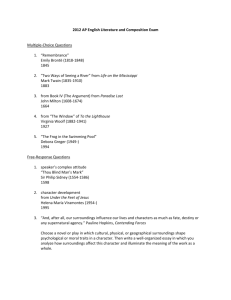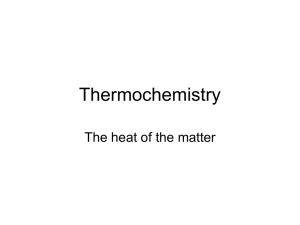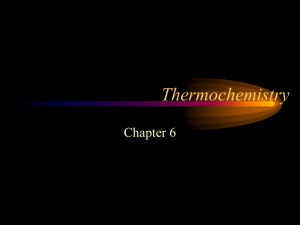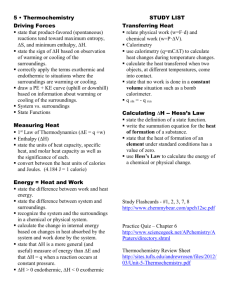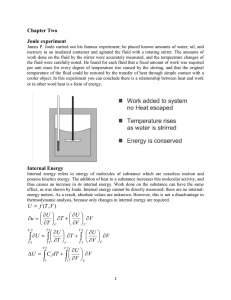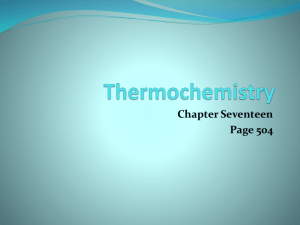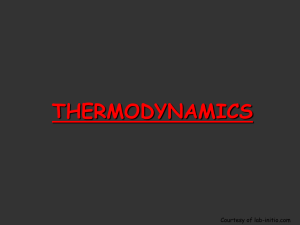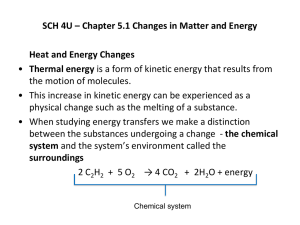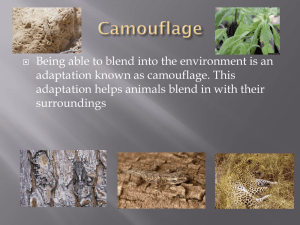Worksheet – 1st Law The First Law of Thermodynamics states that
advertisement
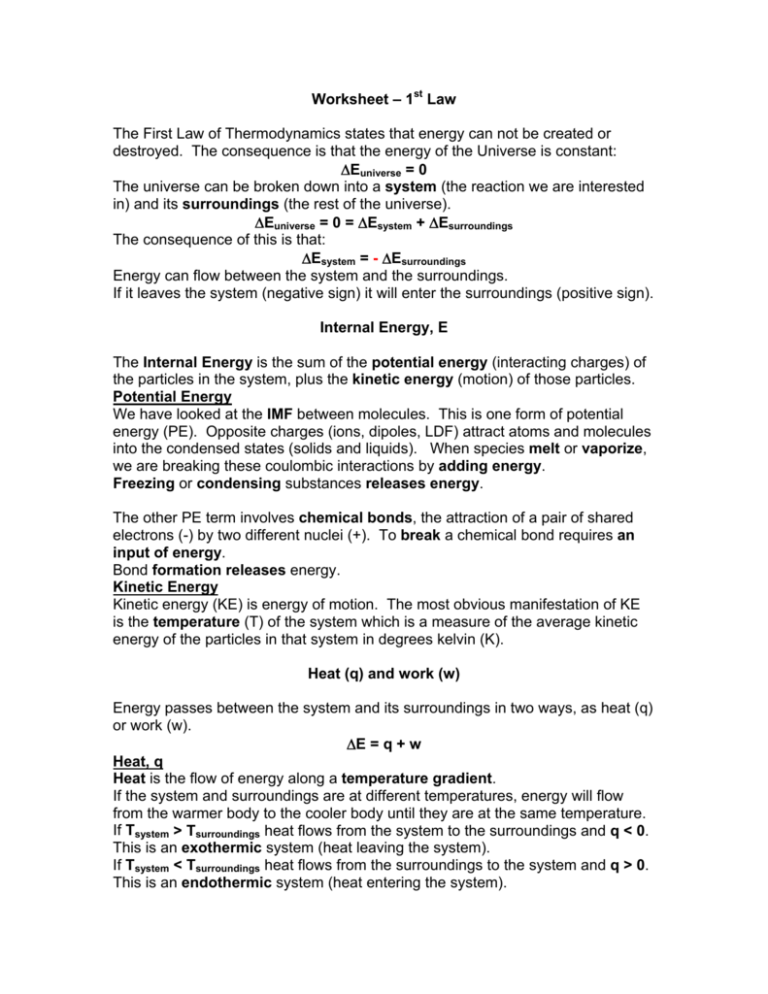
Worksheet – 1st Law The First Law of Thermodynamics states that energy can not be created or destroyed. The consequence is that the energy of the Universe is constant: Euniverse = 0 The universe can be broken down into a system (the reaction we are interested in) and its surroundings (the rest of the universe). Euniverse = 0 = Esystem + Esurroundings The consequence of this is that: Esystem = - Esurroundings Energy can flow between the system and the surroundings. If it leaves the system (negative sign) it will enter the surroundings (positive sign). Internal Energy, E The Internal Energy is the sum of the potential energy (interacting charges) of the particles in the system, plus the kinetic energy (motion) of those particles. Potential Energy We have looked at the IMF between molecules. This is one form of potential energy (PE). Opposite charges (ions, dipoles, LDF) attract atoms and molecules into the condensed states (solids and liquids). When species melt or vaporize, we are breaking these coulombic interactions by adding energy. Freezing or condensing substances releases energy. The other PE term involves chemical bonds, the attraction of a pair of shared electrons (-) by two different nuclei (+). To break a chemical bond requires an input of energy. Bond formation releases energy. Kinetic Energy Kinetic energy (KE) is energy of motion. The most obvious manifestation of KE is the temperature (T) of the system which is a measure of the average kinetic energy of the particles in that system in degrees kelvin (K). Heat (q) and work (w) Energy passes between the system and its surroundings in two ways, as heat (q) or work (w). E = q + w Heat, q Heat is the flow of energy along a temperature gradient. If the system and surroundings are at different temperatures, energy will flow from the warmer body to the cooler body until they are at the same temperature. If Tsystem > Tsurroundings heat flows from the system to the surroundings and q < 0. This is an exothermic system (heat leaving the system). If Tsystem < Tsurroundings heat flows from the surroundings to the system and q > 0. This is an endothermic system (heat entering the system). 1. Give the sign of q for each of the following processes when the system and surroundings are at different temperatures. a. steam condenses on a cold window b. warm milk is placed in a refrigerator c. ice cream is left on the countertop + + + - The temperature of a system will also change during chemical reactions, which involve bond breakage and formation. There in an interconversion of KE (T) and PE (bonds and IMF). If one increases, the other will decrease. PE 2. If there is net bond breakage in a reaction, a. the PE will (increase or decrease) b. the KE will (increase or decrease). c. the Tproducts will be (higher or lower) than the Treactants. d. q (> or <) 0 e. this is an (endothermic or exothermic) reaction. f. draw the relative energy levels for the reactants and products Work We will be looking initially at mechanical work. It will be defined as: w = -PexternalV where Pexternal is the external pressure and V is Vfinal – Vinitial, the change in the gaseous volume of the system due to the reaction. We will often have to use the Ideal Gas Law in these calculations: PV = nRT where P = the pressure of the system in atmospheres V = volume in L n = number of moles of gas R = gas constant = 0.08206 L atm/mol K T = temperature (K) 3. If the reaction leads to an increase in the moles of gas, at constant T: a. V ( > or <) 0 b. w (> or <) 0 c. work (enters or leaves) the system 4. What is the sign for w in each of the following processes? a. 2 SrO(s) + 2 F2 (g) 2 SrF2 (s) + O2 (g) b. steam condenses on a cold window c. 2 NH4NO3 (s) 2 N2 (g) + 4 H2O (l) + O2 (g) + + + - 5. 900 joules of heat are added to a system and 200 joules of work are done on the system. What is E? 6. Calculate w for a system that absorbs 260 kJ of heat and for which E = 157 kJ. Is the work done on or by the system? Does the system expand or contract? 7. Two liters of an ideal gas is expanded into a vacuum and the new volume is 4 L. If 500 J of heat flow out of the container, what is the change in the internal energy of the system? 8. A balloon is inflated to its full extent by heating the air inside it, using 6.3 x 108J of heat. The initial volume is 2.5 x 103 L. Assume that the balloon expands against a constant pressure of 1.0 atm. The change in internal energy is 5.8 x 108 J. What is the final volume of the balloon? (101.3 J = 1 L atm)

